Lan Chen
ReasoningTrack: Chain-of-Thought Reasoning for Long-term Vision-Language Tracking
Aug 07, 2025Abstract:Vision-language tracking has received increasing attention in recent years, as textual information can effectively address the inflexibility and inaccuracy associated with specifying the target object to be tracked. Existing works either directly fuse the fixed language with vision features or simply modify using attention, however, their performance is still limited. Recently, some researchers have explored using text generation to adapt to the variations in the target during tracking, however, these works fail to provide insights into the model's reasoning process and do not fully leverage the advantages of large models, which further limits their overall performance. To address the aforementioned issues, this paper proposes a novel reasoning-based vision-language tracking framework, named ReasoningTrack, based on a pre-trained vision-language model Qwen2.5-VL. Both SFT (Supervised Fine-Tuning) and reinforcement learning GRPO are used for the optimization of reasoning and language generation. We embed the updated language descriptions and feed them into a unified tracking backbone network together with vision features. Then, we adopt a tracking head to predict the specific location of the target object. In addition, we propose a large-scale long-term vision-language tracking benchmark dataset, termed TNLLT, which contains 200 video sequences. 20 baseline visual trackers are re-trained and evaluated on this dataset, which builds a solid foundation for the vision-language visual tracking task. Extensive experiments on multiple vision-language tracking benchmark datasets fully validated the effectiveness of our proposed reasoning-based natural language generation strategy. The source code of this paper will be released on https://github.com/Event-AHU/Open_VLTrack
ESTR-CoT: Towards Explainable and Accurate Event Stream based Scene Text Recognition with Chain-of-Thought Reasoning
Jul 02, 2025Abstract:Event stream based scene text recognition is a newly arising research topic in recent years which performs better than the widely used RGB cameras in extremely challenging scenarios, especially the low illumination, fast motion. Existing works either adopt end-to-end encoder-decoder framework or large language models for enhanced recognition, however, they are still limited by the challenges of insufficient interpretability and weak contextual logical reasoning. In this work, we propose a novel chain-of-thought reasoning based event stream scene text recognition framework, termed ESTR-CoT. Specifically, we first adopt the vision encoder EVA-CLIP (ViT-G/14) to transform the input event stream into tokens and utilize a Llama tokenizer to encode the given generation prompt. A Q-former is used to align the vision token to the pre-trained large language model Vicuna-7B and output both the answer and chain-of-thought (CoT) reasoning process simultaneously. Our framework can be optimized using supervised fine-tuning in an end-to-end manner. In addition, we also propose a large-scale CoT dataset to train our framework via a three stage processing (i.e., generation, polish, and expert verification). This dataset provides a solid data foundation for the development of subsequent reasoning-based large models. Extensive experiments on three event stream STR benchmark datasets (i.e., EventSTR, WordArt*, IC15*) fully validated the effectiveness and interpretability of our proposed framework. The source code and pre-trained models will be released on https://github.com/Event-AHU/ESTR-CoT.
Dynamic Graph Induced Contour-aware Heat Conduction Network for Event-based Object Detection
May 19, 2025Abstract:Event-based Vision Sensors (EVS) have demonstrated significant advantages over traditional RGB frame-based cameras in low-light conditions, high-speed motion capture, and low latency. Consequently, object detection based on EVS has attracted increasing attention from researchers. Current event stream object detection algorithms are typically built upon Convolutional Neural Networks (CNNs) or Transformers, which either capture limited local features using convolutional filters or incur high computational costs due to the utilization of self-attention. Recently proposed vision heat conduction backbone networks have shown a good balance between efficiency and accuracy; however, these models are not specifically designed for event stream data. They exhibit weak capability in modeling object contour information and fail to exploit the benefits of multi-scale features. To address these issues, this paper proposes a novel dynamic graph induced contour-aware heat conduction network for event stream based object detection, termed CvHeat-DET. The proposed model effectively leverages the clear contour information inherent in event streams to predict the thermal diffusivity coefficients within the heat conduction model, and integrates hierarchical structural graph features to enhance feature learning across multiple scales. Extensive experiments on three benchmark datasets for event stream-based object detection fully validated the effectiveness of the proposed model. The source code of this paper will be released on https://github.com/Event-AHU/OpenEvDET.
Towards Low-Latency Event Stream-based Visual Object Tracking: A Slow-Fast Approach
May 19, 2025Abstract:Existing tracking algorithms typically rely on low-frame-rate RGB cameras coupled with computationally intensive deep neural network architectures to achieve effective tracking. However, such frame-based methods inherently face challenges in achieving low-latency performance and often fail in resource-constrained environments. Visual object tracking using bio-inspired event cameras has emerged as a promising research direction in recent years, offering distinct advantages for low-latency applications. In this paper, we propose a novel Slow-Fast Tracking paradigm that flexibly adapts to different operational requirements, termed SFTrack. The proposed framework supports two complementary modes, i.e., a high-precision slow tracker for scenarios with sufficient computational resources, and an efficient fast tracker tailored for latency-aware, resource-constrained environments. Specifically, our framework first performs graph-based representation learning from high-temporal-resolution event streams, and then integrates the learned graph-structured information into two FlashAttention-based vision backbones, yielding the slow and fast trackers, respectively. The fast tracker achieves low latency through a lightweight network design and by producing multiple bounding box outputs in a single forward pass. Finally, we seamlessly combine both trackers via supervised fine-tuning and further enhance the fast tracker's performance through a knowledge distillation strategy. Extensive experiments on public benchmarks, including FE240, COESOT, and EventVOT, demonstrate the effectiveness and efficiency of our proposed method across different real-world scenarios. The source code has been released on https://github.com/Event-AHU/SlowFast_Event_Track.
Tuning-Free Image Editing with Fidelity and Editability via Unified Latent Diffusion Model
Apr 08, 2025Abstract:Balancing fidelity and editability is essential in text-based image editing (TIE), where failures commonly lead to over- or under-editing issues. Existing methods typically rely on attention injections for structure preservation and leverage the inherent text alignment capabilities of pre-trained text-to-image (T2I) models for editability, but they lack explicit and unified mechanisms to properly balance these two objectives. In this work, we introduce UnifyEdit, a tuning-free method that performs diffusion latent optimization to enable a balanced integration of fidelity and editability within a unified framework. Unlike direct attention injections, we develop two attention-based constraints: a self-attention (SA) preservation constraint for structural fidelity, and a cross-attention (CA) alignment constraint to enhance text alignment for improved editability. However, simultaneously applying both constraints can lead to gradient conflicts, where the dominance of one constraint results in over- or under-editing. To address this challenge, we introduce an adaptive time-step scheduler that dynamically adjusts the influence of these constraints, guiding the diffusion latent toward an optimal balance. Extensive quantitative and qualitative experiments validate the effectiveness of our approach, demonstrating its superiority in achieving a robust balance between structure preservation and text alignment across various editing tasks, outperforming other state-of-the-art methods. The source code will be available at https://github.com/CUC-MIPG/UnifyEdit.
Edit Transfer: Learning Image Editing via Vision In-Context Relations
Mar 17, 2025Abstract:We introduce a new setting, Edit Transfer, where a model learns a transformation from just a single source-target example and applies it to a new query image. While text-based methods excel at semantic manipulations through textual prompts, they often struggle with precise geometric details (e.g., poses and viewpoint changes). Reference-based editing, on the other hand, typically focuses on style or appearance and fails at non-rigid transformations. By explicitly learning the editing transformation from a source-target pair, Edit Transfer mitigates the limitations of both text-only and appearance-centric references. Drawing inspiration from in-context learning in large language models, we propose a visual relation in-context learning paradigm, building upon a DiT-based text-to-image model. We arrange the edited example and the query image into a unified four-panel composite, then apply lightweight LoRA fine-tuning to capture complex spatial transformations from minimal examples. Despite using only 42 training samples, Edit Transfer substantially outperforms state-of-the-art TIE and RIE methods on diverse non-rigid scenarios, demonstrating the effectiveness of few-shot visual relation learning.
VELoRA: A Low-Rank Adaptation Approach for Efficient RGB-Event based Recognition
Dec 28, 2024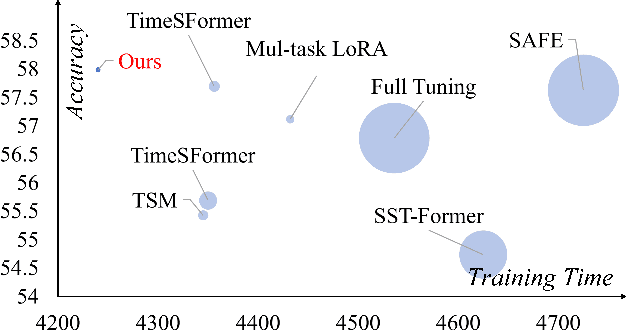

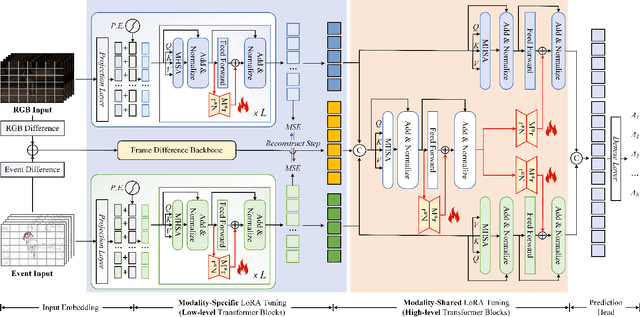

Abstract:Pattern recognition leveraging both RGB and Event cameras can significantly enhance performance by deploying deep neural networks that utilize a fine-tuning strategy. Inspired by the successful application of large models, the introduction of such large models can also be considered to further enhance the performance of multi-modal tasks. However, fully fine-tuning these models leads to inefficiency and lightweight fine-tuning methods such as LoRA and Adapter have been proposed to achieve a better balance between efficiency and performance. To our knowledge, there is currently no work that has conducted parameter-efficient fine-tuning (PEFT) for RGB-Event recognition based on pre-trained foundation models. To address this issue, this paper proposes a novel PEFT strategy to adapt the pre-trained foundation vision models for the RGB-Event-based classification. Specifically, given the RGB frames and event streams, we extract the RGB and event features based on the vision foundation model ViT with a modality-specific LoRA tuning strategy. The frame difference of the dual modalities is also considered to capture the motion cues via the frame difference backbone network. These features are concatenated and fed into high-level Transformer layers for efficient multi-modal feature learning via modality-shared LoRA tuning. Finally, we concatenate these features and feed them into a classification head to achieve efficient fine-tuning. The source code and pre-trained models will be released on \url{https://github.com/Event-AHU/VELoRA}.
Treat Stillness with Movement: Remote Sensing Change Detection via Coarse-grained Temporal Foregrounds Mining
Aug 15, 2024
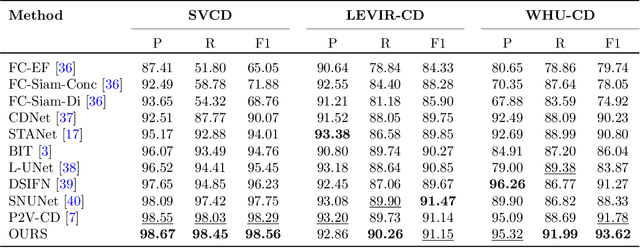
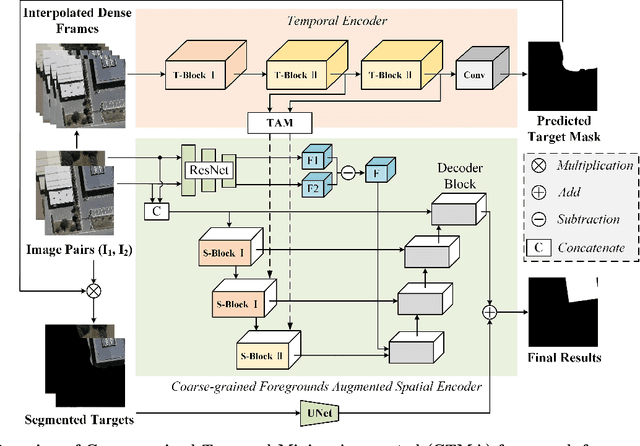

Abstract:Current works focus on addressing the remote sensing change detection task using bi-temporal images. Although good performance can be achieved, however, seldom of they consider the motion cues which may also be vital. In this work, we revisit the widely adopted bi-temporal images-based framework and propose a novel Coarse-grained Temporal Mining Augmented (CTMA) framework. To be specific, given the bi-temporal images, we first transform them into a video using interpolation operations. Then, a set of temporal encoders is adopted to extract the motion features from the obtained video for coarse-grained changed region prediction. Subsequently, we design a novel Coarse-grained Foregrounds Augmented Spatial Encoder module to integrate both global and local information. We also introduce a motion augmented strategy that leverages motion cues as an additional output to aggregate with the spatial features for improved results. Meanwhile, we feed the input image pairs into the ResNet to get the different features and also the spatial blocks for fine-grained feature learning. More importantly, we propose a mask augmented strategy that utilizes coarse-grained changed regions, incorporating them into the decoder blocks to enhance the final changed prediction. Extensive experiments conducted on multiple benchmark datasets fully validated the effectiveness of our proposed framework for remote sensing image change detection. The source code of this paper will be released on https://github.com/Event-AHU/CTM_Remote_Sensing_Change_Detection
Retain, Blend, and Exchange: A Quality-aware Spatial-Stereo Fusion Approach for Event Stream Recognition
Jun 27, 2024Abstract:Existing event stream-based pattern recognition models usually represent the event stream as the point cloud, voxel, image, etc., and design various deep neural networks to learn their features. Although considerable results can be achieved in simple cases, however, the model performance may be limited by monotonous modality expressions, sub-optimal fusion, and readout mechanisms. In this paper, we propose a novel dual-stream framework for event stream-based pattern recognition via differentiated fusion, termed EFV++. It models two common event representations simultaneously, i.e., event images and event voxels. The spatial and three-dimensional stereo information can be learned separately by utilizing Transformer and Graph Neural Network (GNN). We believe the features of each representation still contain both efficient and redundant features and a sub-optimal solution may be obtained if we directly fuse them without differentiation. Thus, we divide each feature into three levels and retain high-quality features, blend medium-quality features, and exchange low-quality features. The enhanced dual features will be fed into the fusion Transformer together with bottleneck features. In addition, we introduce a novel hybrid interaction readout mechanism to enhance the diversity of features as final representations. Extensive experiments demonstrate that our proposed framework achieves state-of-the-art performance on multiple widely used event stream-based classification datasets. Specifically, we achieve new state-of-the-art performance on the Bullying10k dataset, i.e., $90.51\%$, which exceeds the second place by $+2.21\%$. The source code of this paper has been released on \url{https://github.com/Event-AHU/EFV_event_classification/tree/EFVpp}.
Belief Information based Deep Channel Estimation for Massive MIMO Systems
Jun 23, 2024


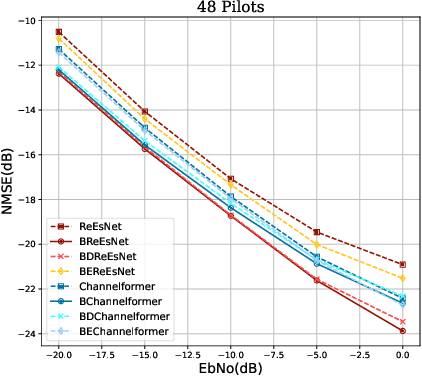
Abstract:In the next generation wireless communication system, transmission rates should continue to rise to support emerging scenarios, e.g., the immersive communications. From the perspective of communication system evolution, multiple-input multiple-output (MIMO) technology remains pivotal for enhancing transmission rates. However, current MIMO systems rely on inserting pilot signals to achieve accurate channel estimation. As the increase of transmit stream, the pilots consume a significant portion of transmission resources, severely reducing the spectral efficiency. In this correspondence, we propose a belief information based mechanism. By introducing a plug-and-play belief information module, existing single-antenna channel estimation networks could be seamlessly adapted to multi-antenna channel estimation and fully exploit the spatial correlation among multiple antennas. Experimental results demonstrate that the proposed method can either improve 1 ~ 2 dB channel estimation performance or reduce 1/3 ~ 1/2 pilot overhead, particularly in bad channel conditions.
 Add to Chrome
Add to Chrome Add to Firefox
Add to Firefox Add to Edge
Add to Edge